the Counter-Reformation
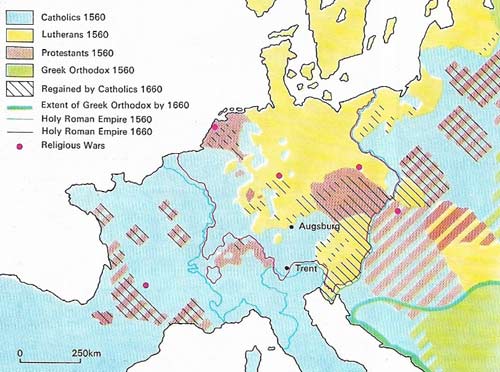
Figure 1. The Counter-Reformation in the century following the Council of Trent won back much of the territory lost to Protestantism. It was most successful in achieving a popular reconversion in Poland, where the enactment of religious toleration in 1573 led to a sudden growth in Jesuit activity in the field of education until the support of Sigismund III (r. 1587-1632) for the Jesuit cause led to the complete suppression of Protestantism. The Counter-Reformation was often marked by the banning of “heretical” books. Catholic control of higher education. Supported by royal and noble families, and the denial of Protestant rights. Its success was often achieved by war.
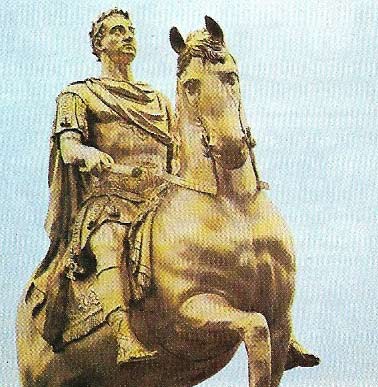
Figure 2. William of Orange (1533-1584), “the Silent”, was the largest landowner in The Netherlands. He led the opposition to Philip II’s erosion of the aristocratic and constitutional liberties of The Netherlands. During the war William tried to unify the provinces, which were jealous of their rights and promoted religious toleration to prevent a rift between Protestants and Catholics in their defence of common constitutional rights. Dutch independence was recognized in 1648.
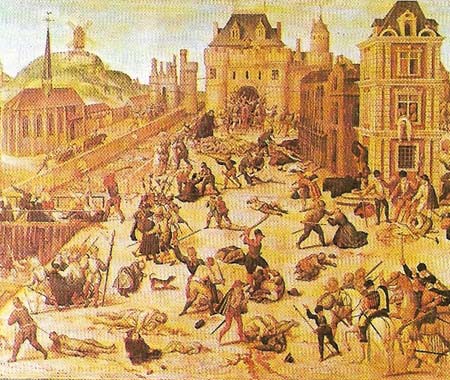
Figure 3. The Massacre of St Bartholomew’s Day – 24 Aug 1572 – was a slaughter of French Protestants (Huguenots). The massacre spread throughout France leading to the outbreak of civil war. Catherine de Medici (1519-1589), the French regent, alarmed at the growing Huguenot political power, plotted against the leaders and instigated the massacre.
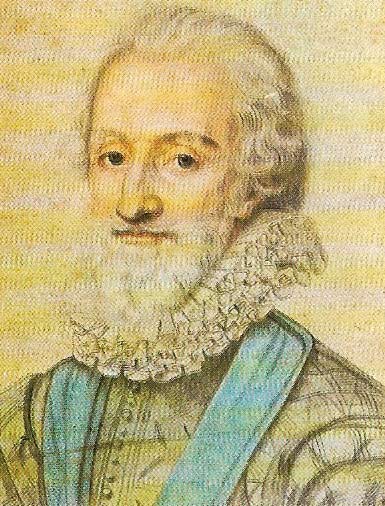
Figure 4. The Protestant Henry of Navarre (1553-1610) became heir to the French throne in 1584 after the death of the Duke of Anjou. From that date and after more than 20 years of civil war in France the political and religious situation was reversed. Now the Catholics feared repression and the Guise feared subjection. Catholics, formerly apologists for divine monarchy, penned tracts justifying rebellion. But Henry of Navarre, who became king in 1589, finally brought peace to France. Renouncing his former Protestantism (saying "Paris is worth a Mass") he thus separated Protestantism from the House of a Bourbon. By tolerating the Huguenots on the Edict of Nantes (1598) he appeased his former allies and ended the French civil wars.
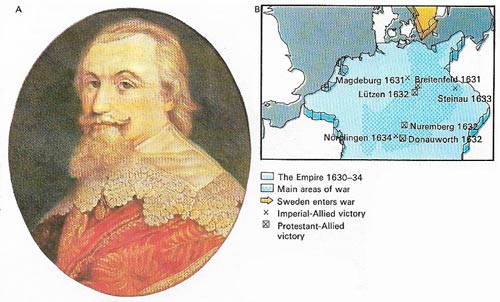
Figure 5. Gustavus Adolphus (A) came to the throne of Sweden in 1611 and as a young man defeated Denmark, Poland and also Russia. He built a fleet and a formidable army which transformed Sweden into a great power. The threat to Sweden was the Hapsburg Catholic control of northern Germany (B). The Polish war persuaded Gustavus to postpone a defensive war against the Hapsburgs in the Baltic, but growing Hapsburg strength after 1629 threatened Swedish security as well as Swedish Protestantism. The Swedes won resounding victories at Breitenfeld in 1631 and Lutzen in 1632 but Gustavus Adolphus was killed in the latter battle and without leadership the Swedes were routed at Nordlingen, 1634.
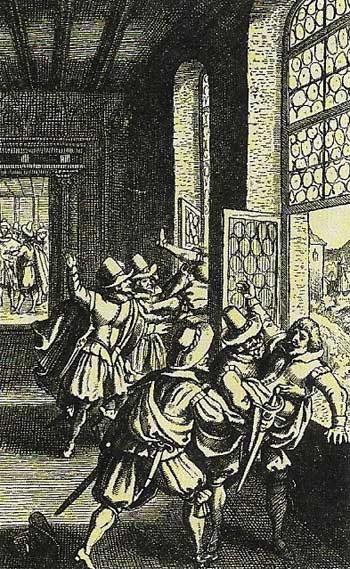
Figure 6. The Defenestration of Prague occurred in 1618 when the Bohemian Protestants hurled two imperial regents from a council window. In 1609 they had obtained from Emperor Rudolph II (1552-1612) a guarantee of religious equality and freedom of worship. Rudolph was succeeded by the old and sick Matthias, who was urged to name as his successor the king of Bohemia. Although they disliked Ferdinand of Syria, the Bohemians consented to his election. The crisis occurred after Matthias had visited Prague securing the election. In his absence the ten regents he appointed denounced the decree of religious freedom and demolished Lutheran churches.
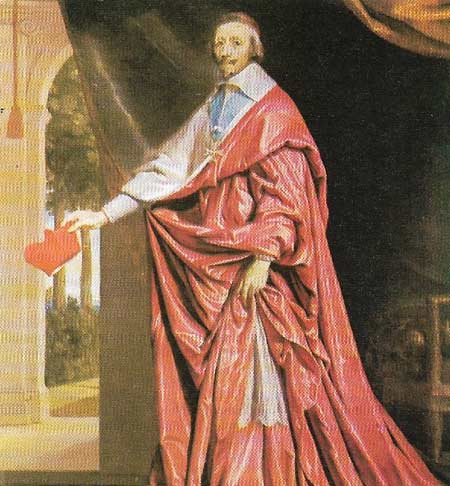
Figure 7. The policies of Cardinal Richelieu (1585-1642), minister to Louis XIII, reflected the French conflict of interests at home and abroad. The French saw the Catholic Hapsburgs as their greatest threat. If Philip II and III had established strong controls in both Spain and the Low Countries, France would have been sandwiched between two branches of a hostile power. It was the dilemma of the French monarchy that its interests required Catholic orthodoxy at home but support of the Protestant cause abroad. From 1634 Richelieu brought France openly into war with the emperor (until 1648) and with Spain.
The Reformation in the early 1500s divided Europe into the Catholic countries of the south and the Protestant countries of the north. Under the protection of the German princes Protestantism became established and the Holy Roman Empire existed in an uneasy state of religious cold war. In the 16th century it was believed that two religions could not coexist in one political community. Heterodoxy, championed by the princes, was an assault upon the secular as well as the spiritual order.
Within the Catholic Church, reformist cardinals such as Gasparo Contarini (1483–1542) advocated a conciliatory policy and reform of abuses. But discussions be-tween Catholics and Protestants at the Diet of Regensburg in 1541 revealed only the impossibility of a compromise and blasted hopes of a revived Christian unity.
Since the Lutheran Reformation a new, formidable Protestantism had assaulted the Catholic Church – the organized Church of John Calvin. As Protestants gained ground in Germany and Switzerland, and missionaries went out from Geneva to France and the Low Countries, the Catholic Church realized the need for action. Between 1536 and 1545 Pope Paul III repeatedly called for a general council, but was forced to postpone it for political reasons. The council finally met in Trent on 15 December 1545. Ostensibly this was a council for all Christendom. But the location in the Italian Alps and Pope Paul's successful coup in determining votes by representative rather than by nation ensured an Italian, papal dominance.
The new orthodoxy
Contarini's followers still hoped for reconciliation with the Protestants. Cardinal Gian Petro Caraffa (1476–1559) and his party were in no such mood. Meeting in three sessions, (1545–1547, 1551–1552, 1562–1563) the council answered the Lutheran challenge for the first time. On all major points of theological controversy, concerning salvation, transubstantiation, and the authority of the fathers, the Catholic position was reasserted with a clarity that late medieval theology had lacked. The council made token reforms of the glaring abuses. Most important, the Council of Trent reinforced the authorities of the Church from the bishops to the pope, whose supremacy was not questioned. The defenders of a new orthodoxy were already armed with the Inquisition (established in 1233) and the papal Index of prohibited books. Trent made the Roman Catholic Church one denomination among many – but a denomination that was ready to fight. Even before the council met, Ignatius Loyola (1491–1556), who was appointed general of the Society of Jesus in 1541, a year after the pope's approval, had provided an army of missionaries – the Jesuits.
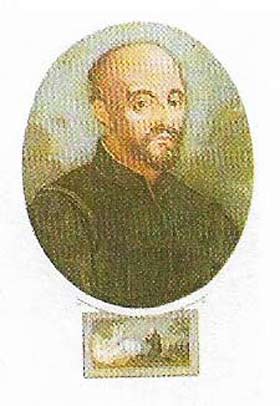 |
Ignatius de Loyola was a Spanish nobleman born in 1491. He underwent a religious experience during a period of convalescence after being wounded in battle. After studying theology at the Sorbonne in Paris in 1534 he formed a group of devout men who swore to serve Christ and his vicar on earth, the pope. His religious order, the Society of Jesus, was strictly organized, it’s members being subject to rigorous discipline. The theology outlined by Loyola in his Spiritual Exercises has been. Described as a “shock-tactic spiritual gymnastic”. Originally, membership was confined to 60 Jesuits, but in 1540 the pope authorised the order to increase its membership without limit. By 1556 the order was firmly established in Europe and it grew greatly in size until the mid-17th century, acting as the principal agent of the Counter-Reformation. It conducted widespread missionary work. |
Beginnings of a religious war
The end of a policy of conciliation meant religious war. Where nobles and princes had emerged as the patrons of the Protestant faiths it meant civil war. In France the rival noble factions of Bourbon and Guise adopting the cause of Calvinism and Tridentine Catholicism (Roman Catholicism as reformed at the Council of Trent) began 30 years of conflict. Political ambition was often the handmaiden of religious zeal.
The popes looked to the Catholic princes of Europe to be the secular arm of Tridentine decrees. In particular they looked to the principal heir of Charles V – Philip II of Spain (1527–1598). In an attempt to exercise greater control over the prosperous Low Countries Philip introduced the Inquisition. Only during the course of revolt did Calvinism find its champions in the defenders of the Netherlanders' privileges.
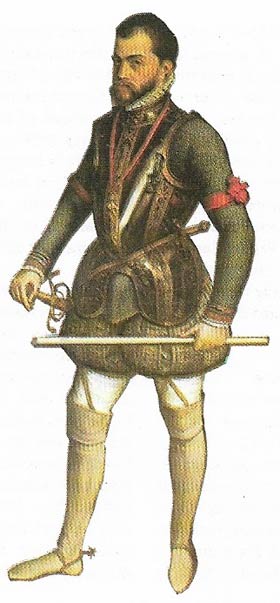 |
| Philip II of Spain dominated European politics in the late 16th century. Philip was looked to as the champion of the Counter-Reformation Catholic Church. In practice, as more than one pope complained, he defended first and foremost the interests of the Hapsburgs. His identification of the Hapsburgs with the Catholic interest, using the inquisition in Spain, complicated the religious and political life of Europe and he was involved constantly in war – against the Turks, the rebellious Dutch, the French Huguenots and the English. Philip made Spain a great power, but in the process he aligned against her almost all the states of Europe. |
In 1555 the Peace of Augsburg had brought a temporary lull to conflict in Germany. For the rest of the century the empire remained in uneasy peace as the Hapsburgs tried to reestablish their authority and the Calvinists (not recognized in the peace) gained ground. The Catholic princes of Germany, acting independently of the emperor, formed their own political league under Maximilian of Bavaria (1573–1651).
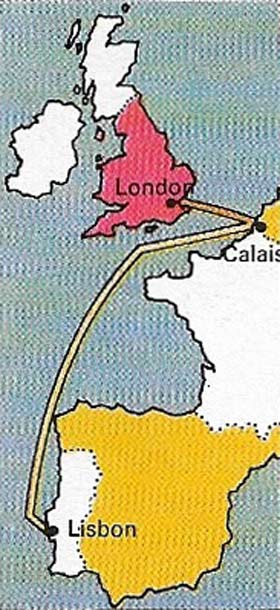 |
| The rebellious Netherlands were helped in their struggle against Spain in the 1560s and 1570s by Elizabeth I of England. It became increasingly evident to Philip II that the Low Countries would not be settled while the rebels received foreign aid. In 1580 Philip successfully pressed a claim to the crown of Portugal and the acquisition of a powerful fleet, together with the increasing revenues from the Indies, perhaps persuaded him to launch the Armada. In league with Leading French Catholics, Philip hoped to put in at French ports, while his regent for The Netherlands, the Duke of Parma, was to clear towns along the coast to meet the Spanish ships. Philip may have intended the conquest of England (we cannot be sure) or more probably have planned to contain the English while Parma militarily reasserted Spanish control in The Netherlands. The Armada was defeated in 1588. |
Thirty Years War
The signal for conflict was given when the Bohemian subjects resisted the decisions of the Emperor Matthias (1557–1619) to make the staunchly Catholic Ferdinand of Styria (1578-1637) king of the Bohemians. The Bohemians wanted neither a Hapsburg nor a Catholic. In 1618 they cast two imperial councillors from the window of the council chamber at Prague and called upon the head of the German Protestants, Frederick the Elector Palatine (1596–1632), to defend their cause (Figure 6). Thirty years of war ensued.
The imperial forces, assisted by Maximilian, crushed Frederick and Hapsburg power was. restored. By 1629 Ferdinand, now emperor, was strong enough to impose an edict restoring to the Catholic Church all lands secularized since 1552, so undermining the territorial strength of the Protestants. But the strengthening of the Hapsburgs and the identification of Spanish and imperial Haps-burgs with Catholicism brought in turn all their enemies against them. The Swedes (Figure 5), then ironically the French, under the Catholic Cardinal Richelieu (Figure 7), fought with the Protestant cause against the Hapsburgs. After 30 years of turmoil the weary Emperor Ferdinand III (1608–1657) signed the Peace of Westphalia, 1648, in which he recognized the Calvinist faith within Germany.
